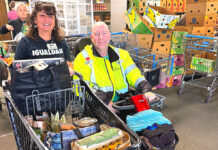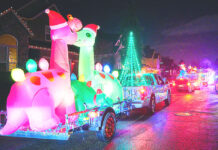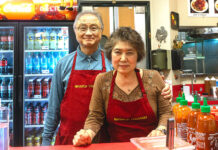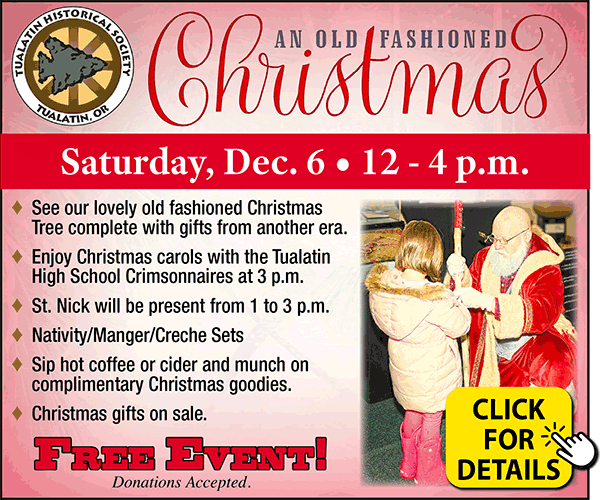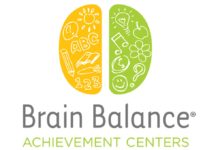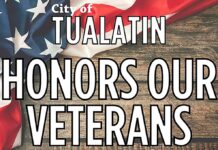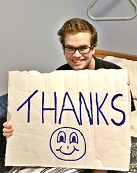
Fourth graders from Tualatin and Bridgeport Elementary Schools “lived history” for several hours last month thanks to hands-on activities about life before electricity and the internet. Lessons stretched back 14,000 years to the Ice Age and the Atfaliti people who lived here from time immemorial. With the exception of the Covid pause, this learning opportunity has been offered by the Tualatin Historical Society annually since 2007.

Students participated in eight different “learning stations”:
Ice Age Animals: Returning in 2025 was the chance for students to learn about evidence from the Ice Age, 14,000 years ago, as they sat beside huge boulders carried into the Willamette Valley on ice rafts. They handled fossils from ancient creatures such as buffalo, mastodons and sloths. Mike Full and Lorena Johnson coordinated this station. Mike pointed out that dinosaurs from earlier eras used to have six sets of teeth, but fossils of these ancient animals have not been discovered in Tualatin.
Native People and Plants: Atfaliti Indians knew how to utilize the abundant natural resources of the Tualatin area, such as hazelnuts, which students ground on stone as indigenous people did. They learned that Oregon grows 99% of all hazelnuts in the USA, a vital ingredient in Nutella, a popular treat that students recognize. They also examined the pelts of beaver, deer, rabbit, badger, squirrel, fox, and coyote. This station was coordinated by Mike Hannigan, Sandra Lafky Carlson, Denise Cline, and Ken Stinger
Homesteading & Land Claims: In the 1850s, the US government gave land to homesteaders moving to Oregon. Their claim was measured using a 66-ft “Gunters’ chain” so settlers could build fences and keep livestock on their property. Students looked on an original donation land claim map of Tualatin and received a certificate showing on whose original homestead their house sits today. April Wicker, Doug Silvey, and Nancy Dunis coordinated this station.



Pioneer Artifacts: Barb Stinger and Rochelle Martinazzi, whose family ties in Tualatin date back over 150 years, helped students guess how old-time household and farm items were used before the advent of blenders, toasters, and microwaves. The artifacts were loaned by Rebecca Pratt, who grew up in Sweek House, Tualatin’s only building on the National Register of Historic Places.
Farming: This new station, for 2025, is located in front of the historic Galbreath farm wagon, now on public display in the Heritage Center orchard. Guided by local farmer Jeff Jensen (Jensen Mini-Farm on Hazelbrook Rd), the 4th graders let Vader, a miniature steer, eat from their hand and learned what the phrase “chewing your cud” means. Bill Avery, who grew up working at Avery Chicken Hatchery on the Tualatin street by that name, described how his father shipped baby chicks to farms from the Tualatin Post Office. Two live hens named Loraine and Sylvia, pets of the Reams family at Tualatin Elementary, happily clucked each day.
Laundry: Students learned that most early settlers only washed some of their clothes every few weeks, and mending was the first step in the laundry process. They got the feel of using a washboard and wringer before hanging the clothes on a drying rack or tree. Emma Gende, Blake Buchanan-Mundo and Noah Zike coordinated this station.



One-Room Schoolhouse: Inside the Heritage Center, a mock classroom was set up to resemble the mid-1800s, serving all grade levels. Students sat on wooden benches with boys and girls separated. Math was called arithmetic, with the youngest children using a slate board and chalk and older students using pencils sharpened with a knife. Cursive penmanship was considered a sign of intelligence. Females could not be married if they wanted to be a teacher. The school “marm” was Pam Rossio, retired from Tualatin Elementary, assisted by Christine Rivas.
Pioneer Toys & Games: Children learned to play common recess toys and games, such as Whirligigs, Jigsaw Puzzles, Marbles, Jacks, Spinning Tops, Jump Ropes, and Flying Graces (rumor has it this game was primarily intended for girls to help them become “more graceful”). Laura Baker, David Skoglund, and Rachel Zike coordinated this station.
This event would not have been possible without the people working behind the scenes. Rebecca Pratt and Richard Hall provided a trailer load of props. In addition, the THS Board, Heritage Center Manager Rick Wheelock, Al Stewart Photography, and the teachers and parent chaperones kept the day moving; several more volunteers assisted with setup and takedown each day.


